Piotr Naskrecki's Blog, page 11
February 10, 2013
Ice-crawlers
Ice crawler Grylloblatta campodeiformis from Alberta, Canada. [Canon 10D. Canon 100mm, ambient light]
Entomologists, unlike birders, usually do not keep life lists of insects, but seeing my first ice crawler (Grylloblattodea) was akin to checking off the first kiwi on a twitcher’s life list. These insects are a strange breed. Only twenty-eight species are known, and they are found only in colder regions of North America and the Far East of Asia. The American species live mostly along the northern coast of the United States and Canada, in the Cascade and Sierra Nevada ranges. There you can find them on northern talus slopes of mountains, as high as three thousand meters or in ice caves.The North American snow-associated species of ice crawlers have very well-developed eyes. These insects are active both during the day and at night and use visual and olfactory cues to find food as they walk on the snow’s surface. [Canon 10D. Canon 100mm, ambient light]
These insects clearly love cold weather. Their optimal temperature of activity hovers around the freezing point, and you can easily kill one by touching it due to the warmth of your hand. And yet they are also not really good at surviving in the extreme cold — a drop in the temperature to below -9°C will also cause them to die. Unlike other cold-loving insects they have never evolved the appropriate levels of glycerol and other antifreezing compounds in their blood. And so, like tiny, six-legged Goldilocks, they seem relegated to a life in narrow, fleeting ranges of environmental variables, constantly searching for just the right temperature and humidity.But a life like this has its advantages: because of their slow, temperature-dependent metabolism, ice crawlers are surprisingly long-lived (for insects) and may reach the ripe age of ten years. Food is usually not a problem as ice crawlers will eat almost anything, ranging from dead insects blown onto the surface of the ice to vegetal matter found under snow. There is not much competition in the subfreezing layers of the soil, especially if you are the largest insect active in this environment, and most predators, such as shrews or toads, tend to stay away from really cold places. Asian species of ice crawlers have slightly higher temperature tolerance and can safely live in the span of 9–15°C. Because many other animals are also active within this range, Asian ice crawlers escape competitors and predators by hiding very deep in the soil or at the bottom of caves.
In contrast to North American species, the fossorial Asian species, like this Japanese Galloisiana nipponensis, which spend their entire life deep underground, are blind and never forage on the surface. [Canon 1Ds MkII, Canon MP-E 65mm, 2 speedlights Canon 580EX]
But in the beginning, the life of these insects used to be very different. Over 250 million years ago, in the Permian, the ancestors of modern ice crawlers were anything but crawlers on ice. For one, all ancient species were equipped with two pairs of large wings. Based on the analysis of the gut content of some remarkably well preserved fossils we know that they fed primarily on pollen of ancient conifers and some of their now-extinct relatives. For millions of years they flourished in hot, tropical parts of the globe, leading a plant-hopping life, quite likely similar to that of many of today’s pollinators. According to some entomologists there used to be as many as 44 families of “ice crawler”–like insects, compared to a single family known today. They are frequently found in rock deposits dating back from the Permian to the Cretaceous.Cool, shady, and humid subalpine and alpine valleys in the beautiful Chichibu-Tama-Kai National Park not far from Tokyo are an example of the typical habitats of Japanese ice crawlers. [Canon 1Ds MkII, Canon 16-35mm]
But then, gradually, they disappeared from the fossil record. Strangely, there is not a single ice crawler known from the period after mid-Cretaceous. Their disappearance coincides roughly with the appearance of flowering plants, or angiosperms, and the nearly concurrent diversification of beetles and other plant pollinators. It seems that rather than allowing themselves to be outcompeted by this new army of more advanced plant-associated insects, the ancestors of ice crawlers found survival in a completely new lifestyle.Japanese species of ice crawlers, or garoamushi, are distinctly larger than their American counterparts and, because of their higher metabolic rates, faster and more difficult to catch. The species most common in Japan is Galloisiana nipponensis. Garoamushi are found primarily in areas that have a mean annual temperature of 12°C, but even in these cool areas they hide deep in the soil throughout most of the year. [Canon 1Ds MkII, Canon MP-E 65mm, 2 speedlights Canon 580EX]
They shed their wings and entered a chilly, inhospitable niche along the edges of glaciers, in caves, or deep in the soil. This explains the lack of a fossil record; fossilization usually requires the sinking of a dead organism into fine silt at the bottom of a lake or an ocean, and so the environments favored by ice crawler ancestors made fossil formation difficult.Although they have been luckier than all their winged, plant-hopping ancestors, the luck of modern ice crawlers may soon run out. Their dependence on a very narrow spectrum of low temperatures, combined with their inability to fly and thus quickly colonize new habitats, may soon spell the end of this ancient lineage in our rapidly warming world. As sometimes happens in evolution, ice crawlers have painted themselves into a corner. During the Pleistocene, when most of the North American continent was covered with a thick ice cap, these insects probably survived only on the edges of the glacier or in underground networks of caves. As the ice receded they followed it and colonized suitably cold (but not too cold) places high on mountain slopes or in icy caves. As a result, populations of these insects tend to be small and genetically isolated from each other due to the island-like nature of cold, alpine habitats. This means that when their environment suddenly becomes uncomfortably warm—and there is already ample evidence of the shrinking of North American glaciers—they have nowhere to go. And even if there still existed available habitats, ice crawlers have no way of getting there because of their inability to fly. Some populations in the Sierra Nevada of California, perhaps entire species of ice crawlers, may already be extinct, as repeated attempts to find them during the last forty years have failed. And when the entire genetic makeup of a lineage consists of only twenty-eight species, every one of them is priceless.
[An excerpt from my book "Relics: Travels in Nature's Time Machine"]
Filed under: Grylloblattodea, Notoptera


February 7, 2013
A view from the other side (a guest post by Kristin)
The very first solifugid that I ever saw. When I posted this photo on Flickr, the always hilarious Brandi Schuster commented, “Solifugid. That sounds like the noise that I would make if I ever saw one of those fuckers in real life.” [Canon G10]
“So, are you afraid of solifugids, too?” my husband asked, questioning me about my life long fear of spiders while writing his first book, The Smaller Majority. Now, I am not your stereotypical girl, revolted by and fearful of insects of all types. I love insects and pride myself on knowing more about them than most laymen. Consequently, I really didn’t want to admit that I didn’t know what a solifugid was, nor did I want to add any other arthropods to my shameful “eek!” list. Picturing something like an amblypigid, I replied, “Pfft, sheesh, phuff, no, of course not. Just spiders.” Little did I know.The first time that I ever saw a solifugid was in South Africa in 2009. Long after nightfall, our group had finally made it to our accommodations – a research station in the hills of Cederberg. The mattresses were stained and soaked with things unholy, and bats were roosting and pooping in the rafters of the kitchen, but the real problem was the spiders. Big, hairy, and speedy.
Spider-free living. Hey, if I believed it, that was all that mattered. [Canon G10]
It began to dawn on me that I couldn’t stay in that room, but we were hours away from any alternative. As I began to wrap my head around this puzzle, I heard commotion outside one of the rooms. Piotr was gasping things like, “Oh boy!” and scrambling for his camera gear in a way that suggested that he’d found something really “cool”, and our friend Maciej was pounding on the door, yelling in his thick Polish accent, “Corey! There’s a solifugid coming into your room!” The doors didn’t meet the floor, you see. Of course they didn’t. There was enough of a gap that the mouse-sized, spider-like thing that we stood staring at was able to skitter under Corey’s door without even ducking its head or pausing at chewing on a grasshopper.The Verandah. Doesn’t it look delightful? Note the interesting choice to install a screen on a door that doesn’t meet the floor, and the lack of a screen on the window. [Canon G10]
So, I finally learned: solifugids look like a cross between a bleached mouse and a spider, and they live in dry regions in South Africa. Also, charmingly, they are carnivores. I slept in the car that night and the following morning we paid the spiders for our room and board. It wasn’t until 2 years later that my solifugid lessons resumed, at graduate level.Again, I was in South Africa. Again, I was in Cederberg. Again we were staying in the type of accommodation that makes biologists “oooh” and “ahhh” and walk around, poking into corners with a junky’s avarice. Make no mistake- Cederberg is one of my favorite spots on the planet. It’s gorgeous and fascinating. It just needs some screens, and I’ll tell you why…
One evening, as the entomologists set out to see what could be found in the darkened crevices of the mountains, I deferred, pulled a couple of chairs to the middle of the verandah, poured some wine, made a snack plate, put my feet up, and opened a book.
It wasn’t long, maybe only a half hour of sipping, reading, nibbling, and pausing to feel the warmth of everything right, before things changed. A cat emerged from an unlit corner and as I leaned forward with an “Oh, hey kit…tie…”, I saw that it was stalking something. A mouse? I thought hopefully, naively. No, this was Africa. The cat was not chasing a mouse. What it was batting at looked like a mouse, to be sure. A large, bleached mouse that began to run like the wind. I froze, recalling platitudes- it’s more scared of me than I am of it; it wants to avoid me; it won’t climb my chair, or the walls, then lose its grip on the ceiling and fall down the back of my shirt collar…
As I was trying to calm myself with this mantra, the solifugid raced directly to my chair, and attempted to climb a leg. I jumped to stand on the chair- though, I couldn’t but note, nowhere near as quickly as the solifugid was moving. Supposedly, they can run over 6 inches per second, which earned them one of their common monikers- wind spiders- but I’m here to insist that when feral cats are chasing them, they easily set new PR’s.
A storm passes over the top of a mountain in Cederberg at the end of a scorchingly hot day. This place is worth every degree and every arachnid above my comfort level. [Canon 7D, Canon 14mm]
The cat was in hot pursuit, so rather than struggle to grip my chair legs and race up to tangle itself in my hair, the solifugid bolted to another dark corner of the porch. Other than seeing the shadowy figure of the cat racing and pouncing, I had no idea where it was. I looked behind me at the door to our chalet. It wasn’t more than 3 feet away, but I didn’t feel confident that I could make it before the solifugid did, wherever it was.Then suddenly, there it was, scrambling up the side of the wall and toward me without losing any of its breakneck speed, the cat trailing it along the floor. I may have screamed, I don’t know. What I do remember was cursing Piotr in my head- while trying to convince me that there was no need to sleep in the car during that first encounter, at the Spider Chalet, he had absentmindedly assured me not to worry, the solifugid wouldn’t climb anything. It was said with the distracted air of a man telling his wife that yes, he has noticed her haircut and likes it, so I should have known better.
Glorious Cederberg. [Canon 7D, Canon 14mm]
As it passed over the door and zoomed back toward the floor, I knew that I had to act. I jumped from the chair and made for the door. The solifugid reversed course and came straight for me. I jumped back up on the chair (I learned later, when relaying this story to Piotr, who seemed to see it more from the solifugid’s perspective than mine, that they seek safety in shadow, and the shadow that I cast as I moved, intent on my own escape, made me an unwitting attractant.)Confused, it turned to dart back toward the shadows again, and this moment’s hesitation allowed the cat to get a good whack in. The solifugid reared up and presented the cat with its enormous, open jaws, and lunged. The cat jumped backed, stunned and impressed. With another lunge for good measure, the solifugid took advantage of the cat’s reverence for its display and zipped into the dark. The cat followed, slowly- back in stalking mode- and I made my second jump from the chair, frantically fumbled the door open, and burst into the cabin, eyeing the gap fretfully and wondering why it wasn’t a priority anywhere in Cederberg to fashion doors to meet the ground.
I sat in the middle of my bed and aimed my headlamp like a sentry at the screenless window, which opened directly onto the verandah that I had just fled, and waited for the others to return from their night collecting. I tried to shut the window, but the heat was unbearable. After a day of baking at well over 114F in the sun, the cabin needed all night to cool down. Hours passed. Finally, I laid back. I opened a nearby book and exhaled. Cue something, of course. It was the cat, jumping in the window. Why? On the tail of the solifugid again? Why else would it have come in? This is what I had to assume. War rules.
I will never know if the cat, which soon exited through the kitchen, came in because it was chasing something. But what I do know is that entomologists can stay out in the dark for eons and, when they return in their exultant state, don’t think to wonder about overturned chairs, scattered snacks, and splayed books in the middle of the porch. They walk right by with their containers and baggies held up for rapturous inspection, like urbanites immersed in their cell phones, and seem startled to see you awake and upright, just before dawn- “Oh, hey baby- what are you doing up?”
![Compared to a solifugid, this tiger spider (Argiope australis) seems like sweet, harmless bunny. [Canon G10]](https://i.gr-assets.com/images/S/compressed.photo.goodreads.com/hostedimages/1389030578i/7973964._SY540_.jpg)
Compared to a solifugid, this tiger spider (Argiope australis) seems like a sweet, harmless bunny. [Canon G10]
Filed under: Arachnida, Guest post


February 5, 2013
African Tuesday: Being bark
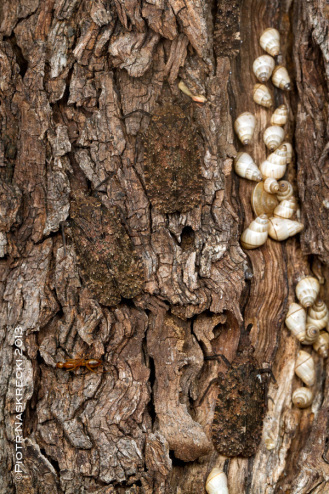
How many insects can you see? I was thrilled to discover that lantern bugs (Druentia variegata) in Gorongosa are visited by several species of insects seeking their sweet honeydew.
When I first read “Out of Africa”, which to this day remains one of my favorite books, the one thing that left me oddly dissatisfied was the lack of attention to trees of the savanna - their smell and colors, the texture of their bark and, most importantly, all the wonderful creatures that the author must have seen among the leaves and branches. How could Isak Dinesen devote so much attention to lions and illicit romance, and not mention amorphoscelid mantids? Sheesh, what was his problem? But perhaps I was asking too much – after all, not everybody spent their childhood picking coreid bugs and geometrid moths off tree trunks, but I wasn’t happy until I could run my hand along the smooth stem of a southern African Acacia, and gasp at the sudden discovery of a gecko hiding in plain sight.
Tree bark may not appear to be a particularly exciting habitat to live in. It is essentially two dimensional, devoid of bright colors, flat. Of course it seems so only from our gargantuan, human perspective. In fact bark is a rich, diverse ecosystem, replete with deep rifts and valleys, covered by amazing vegetation, and as dangerous to live in as the heart of the savanna.
The last time I visited Africa was a few months ago, on the floodplains of Mozambique’s spectacular Gorongosa National Park. It was the beginning of the dry season, and grass was already turning yellow and stiff. With every scorching day fewer and fewer insects were active in the grasslands, and so I turned my attention to the mottled surfaces of tree trunks, hoping to find some hidden treasures. And I wasn’t disappointed.
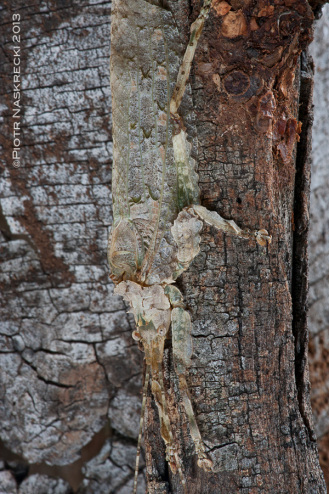
Bark katydid (Cymatomera denticollis) looks just like a flake of bark.
My first discovery was somewhat accidental – it turned out to be one of nature’s most wonderful callers, a maker of melodious, bird-like trills, and I ran into him thanks to my own nature’s call. With a bottle of beer in hand, I was making my way towards a latrine (I was at a small social shindig at one of the field camps), when my other hand met something soft, velvety, and clearly alive on a stem of a small tree. What in any other person would have elicited an immediate withdrawal response, the many years of pursuit of all things small and agile caused my hand to instinctively grasp the animal tighter. Holding onto the tree and still not knowing what was under my hand, I set down the beer bottle and gently pulled the animal off the bark. When I realized what I was holding I nearly failed to deliver the reason of my night walk to its intended destination (i.e., I almost peed my pants) – it was a bark katydid (Cymatomera denticollis), an elusive creature that I only had seen once a decade earlier, and had been trying to find again ever since.
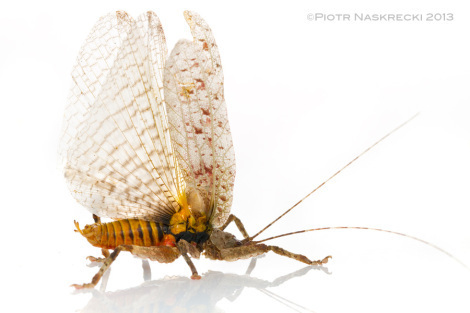
When threatened, bark katydids fan their wings to reveal aposematic coloration and spray the attacker with foul-smelling chemical.
A bark katydid is nothing like your typical, green, leaf-like variety. Its body is flat, covered with fine fuzz that makes them feel warm and soft, and the legs have small lobes that make the animal blend perfectly amongst lichen-covered flakes of African bark. But crypsis is not its only defense – if feeling threatened, the katydid fans its wings, revealing a brightly yellow and black abdomen, and sends a cloud of noxious, foul-smelling chemicals. And this is exactly what happened when I opened my hand to see what was in it, and I nearly dropped the precious animal.
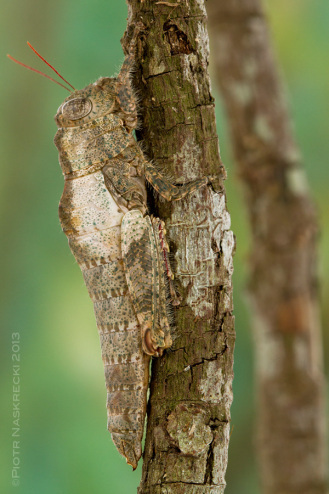
Trees of the southern African savanna are home to wingless grasshoppers of the family Lentulidae. They display many characteristics typical of juvenile stages, and entomologists speculate that this group may be an example of neoteny. (Mecostibus mopanei, Gorongosa).
Over the next couple of months I spent many hours scanning the surface of tree bark in Gorongosa. This simple activity allowed me to discover and collect not only a wide range of fascinating creatures, but also make several interesting discoveries about their behavior. Among others, I found that African lantern bugs (Fulgoridae) might be a part of a complex trophic interaction, similar to what I had studied in Costa Rica, and I will be looking into this system later this year. Most people come to Gorongosa for the landscapes of the Rift Valley and lions. I am going back for the cracks in the bark and tree mantids.
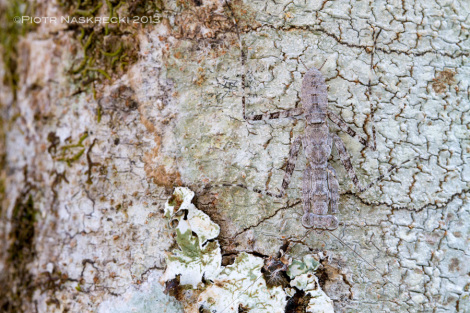
A young praying mantis (Theopompa sp.) is nearly invisible on a lichen-covered bark, and as dangerous to animals living on trees as a lion is to grazers of the Gorongosa plains.
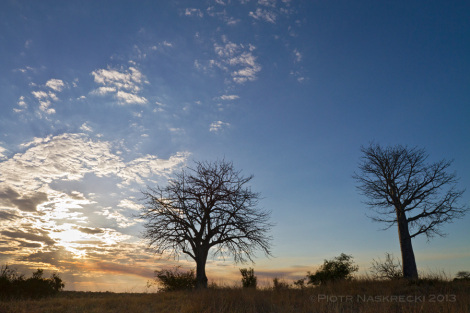
The bark of baobabs (Adansonia digitata), a common tree of Gorongosa, is a great place to look for cryptic animals.
Filed under: African Tuesday, Behavior, Gorongosa, Macrophotography, Orthoptera, Praying mantids


January 25, 2013
What butterflies like
In Eastern Cape of South Africa, a beautiful flock of butterflies is puddling on the side of a road. [Canon 7D, Canon 16-35mm]
The weather has become so unpleasantly cold that I try not to open my eyes while walking outside, out of fear that my eyeballs will freeze. (I was told that this would happen by my teacher in preschool; she also told me that eating candies makes worms lay eggs in my teeth, and that if I eat pears before swimming then I will drown. Why pears and not, let’s say, gooseberries, I have no idea, and I won’t even mention what she said would happen if I ran with scissors.) Anywho, the lifeless season outside the window makes me seek solace in memories of warmer places, luxuriantly abundant with life, and few phenomena better convey the feeling of life’s unbound exuberance than swarms of tropical butterflies.A cluster of puddling butterflies on a sandy river bank in Guyana [Canon 5D, Canon 100-400mm]
Visitors to the tropics are often surprised by the number of butterflies and moths aggregating on muddy banks of rivers, mud puddles and, this usually comes as a surprise, animal dung. Many butterflies are also attracted to human skin and suck sweat or blood from cuts with their proboscis. They love wet, sweaty socks and shoes, and absolutely adore the stuff that seeps out latrines. We may delude ourselves that all butterflies prefer sweet nectar of flowers, but in fact many would rather gorge on the liquid portion of fresh feces.African veined white (Belenois gidica) extracting minerals from wet sand (Eastern Cape, S. Africa) [Canon 7D, Canon 100mm macro]
This behavior, known as puddling, is decidedly more common among male than female butterflies. A series of studies has demonstrated that the main element these insects are after is sodium. Sodium is difficult to find in plant material consumed by the butterfly larvae, although potassium occurs there in abundance. By sucking fluids rich in sodium, adult butterflies try to replace the surplus of the latter element with the former. In extreme cases a moth may imbibe an amount of fluid 600 times its own weight in a single puddling session, expelling the excess water as it drinks and retaining only the precious mineral. It has been shown that a higher sodium content in the male’s body enhances his mating success i.e., fitness. In addition to sodium, moths and butterflies may extract amino acids from soil and animal excrements, and males of some species transfer these compounds to their partners through a spermatophore during mating, thus investing in their offspring.Puddling butterflies turned out to be remarkably skittish – in order to get a wide angle shot of these insects I had to leave the camera in the sand, and use a radio controlled trigger (seen on the left) to get the shots. [Canon 5D, Canon 100-400mm]
While in Guyana a few years ago I noticed a particularly large aggregation of butterflies on the sandy bank of a small river that was lazily flowing near our camp. The patch of sand that the insects were obsessing about didn’t look any different from the rest of the beach, but there had to be something in it that made the butterflies go crazy. I had my suspicions as to what was in the sand, but decided to find out for sure. Alas, after many hours spent crawling around, watching and photographing the butterflies, the reason for their strange behavior was still a mystery. But the following night, as I quietly crept through the forest searching for katydids, I suddenly heard the unmistakable sound of water gushing from a faucet. As quietly as I could I moved closer to the river, and there it was – a huge tapir, taking a leak on the patch of sand where the butterflies loved to aggregate, and where I had just wallowed in for hours. My consolation is that the sodium and amino acids that I surely must have absorbed through my skin might increase my fitness as well.This large aggregation of butterflies puddling in Guyana is probably made up mostly of male individuals. [Canon 1Ds MkII, Canon 16-35mm]
![To some butterflies, residues of my sweat were more tempting than the stuff in the sand (tapir – 0, me – 1) [Canon 5D, Canon 100-400mm]](https://i.gr-assets.com/images/S/compressed.photo.goodreads.com/hostedimages/1389030578i/7973980._SY540_.jpg)
To some butterflies, residues of my sweat were more tempting than the stuff in the sand (tapir – 0, me – 1) [Canon 5D, Canon 100-400mm]
![The best spots to see large aggregations of tropical butterflies are often places visited by large grazers. Their dung often attracts many different species of insects seeking sodium and amino acids. [Canon 7D, Canon 16-35mm]](https://i.gr-assets.com/images/S/compressed.photo.goodreads.com/hostedimages/1389030578i/7973981.jpg)
The best spots to see large aggregations of tropical butterflies are often places visited by large grazers. Their dung often attracts many different species of insects seeking sodium and amino acids. [Canon 7D, Canon 16-35mm]
Filed under: Behavior, Insects, Lepidoptera


January 23, 2013
Life in the season of death
Winter in the Northern Hemisphere – is there anything more unpleasant? To most entomologists living in temperate climates winter is synonymous with the disappearance of everything they love: insect activity and the pleasant buzz of millions of wings, vibrant colors of plants, warm weather. Our beloved animals have long turned to dust, buried themselves into the ground, or entered a stupor so deep that they might as well be dead. It will be long months before the word “green” re-enters our vocabulary, and both our skin and the ground below our feet breathe a sigh of relief.
A female snow scorpionfly (Boreus brumalis) is completely wingless and carries a long ovipositor. [Canon 1D MkII, Canon MP-E 65mm, 2 speedlights Canon 580EX]
But as I walked from my car to work this morning, trying with all my might not to expose any unnecessary fragment of my body to the frigid, dry air, I suddenly remembered that there was an insect, a very interesting one, that flourished in this dead season. I first saw it a few years ago in the middle of February on Wachusett Mountain in MA, jumping on the surface of deep snow like a black, shiny flea. It was a snow scorpionfly, a fascinating insect that up that point was only familiar to me from entomology textbooks.Snow scorpionflies (Boreidae) are fascinating insects that can often be found on snow in temperate forests of the Northern Hemisphere. Their relationships are still somewhat mysterious —traditionally they have been considered a family of scorpionflies (Mecoptera), a group of agile, predaceous insects, but recent molecular and morphological studies suggest that they may be in fact more closely related to parasitic fleas. Regardless of their genetic affinities, these peaceful, moss-feeding creatures resemble little either true scorpionflies or fleas, and both their larvae and adults feed on mosses.
The male has highly modified wings that resemble a pair of scissors. He uses them to claps the female’s elongated mouthparts during mating. [Canon 1D MkII, Canon MP-E 65mm, 2 speedlights Canon 580EX]
But why are they active in the middle of winter? Bodies of all living cells contain a very high proportion of water, which turns into ice crystals when the temperature falls below 0°C, damaging the cell structure and potentially killing the organism. And yet, even in the middle of winter snow scorpionflies are not alone. Many arthropods have evolved physiological adaptations that allow them to survive and be active in subfreezing temperatures. As ectotherms, animals that cannot generate their own body heat, winter insects and spiders must possess the ability to supercool their body fluids in order to remain active in subfreezing conditions. Supercooling, a process that allows them to lower their body temperature to well below the water’s freezing point and still maintain its liquid state, is achieved by the presence of polyhydric alcohols and antifreeze proteins in their hemolymph and cells.If he cannot get hold of her mouthparts, the males will sometimes grab the female’s antennae to secure her position on his back. [Canon 1D MkII, Canon MP-E 65mm, 2 speedlights Canon 580EX]
Like other winter-active insects, snow scorpionflies take advantage of the fact that most predators that target insects disappear in the cold months, and come out in large numbers to mate. The larger and chunkier female is completely wingless, whereas the male has a pair of strangely modified, scissor-like wings, which he uses to clasp the female’s mouthparts and secure her position on his back during mating. After mating the female uses her long, external ovipositor to lay eggs in clumps of moss, where they will stay dormant until spring.I have not seen scorpionflies this year, yet, but I will look for them. These animals may be about the size of a pinhead, but for me, in this season, they loom large.
Filed under: Behavior, Insects, Mecoptera


January 21, 2013
Stalk-eyed flies
Stalk-eyed fly (Diasemopsis fasciata) from Gorongosa National Park in Mozambique [Canon 7D, Canon MP-E 65mm, 3 speedlights Canon 580EXII]
I really don’t like when organisms that deviate from our narrow, anthropocentric perception of the natural world are described as “bizarre” but, let’s face it, flies of the family Diopsidae sure look that way. They are hypercephalic, which means that their head is extremely expanded in a way that places both their eyes and the antennae at the tips of very long, often almost horizontal stalks. This family of flies is not the only one that has eyes placed on long stalks, but in Diopsidae this feature is nearly universal. Diopsidae occur mostly in Africa and SE Asia, although two species are found also in North America and one in Europe. (One species is apparently quite common in Massachusetts, and I will definitely try to find it next summer.)With eyes on such long stalks, keeping them clean is not an easy task. Not surprisingly, diopsid flies spend a lot of time on personal hygiene. [Canon 7D, Canon MP-E 65mm, 3 speedlights Canon 580EXII]
Although flies with hypercephalic features are considered a classic case of sexual selection driving the development of exaggerated morphological characters, Diopsidae don’t quite fit this explanation as both males and females have similar, greatly modified heads. In some species, however, sexual dimorphism exists, and males have longer eye-stalks than females. In such species females preferentially mate with males having the longest stalks, and these matings result in increased fitness of the females. Males engage in long, ritualized contests, where they clash with their heads, and the winner is almost always the individual with more widely separated eyes. This is because of a phenomenon known as hyperallometry – the larger the armament, the larger the body size, and thus the strength of the individual. Such contests serve as a simple way to assess the overall size of the rival, and smaller individuals will quickly give up the duel, sensing the strength of the larger rival.It is not surprising that carrying your eyeballs at the ends of a long broomstick does not make your life any easier, and it has been shown that males who have particularly long stalks must also develop larger wings to compensate for the drag caused by their eyes. This, in turn, supports the idea of the “Handicap model” of sexual selection in these flies – because the long eye stalks make the male’s life more difficult, surely he must be a carrier of some excellent genetic material to be able to overcome the handicap of the gargantuan ornaments.
—————–
Update (22 Jan. 13): Thanks to Hans Feijen identifying the fly species, which turned out to be Diasemopsis fasciata, and not Diopsis.
![Stalk-eyed flies usually spend the night in large roosts close to small bodies of water (Guinea) [Nikon D1x, Sigma 180mm, flash Nikon SB-28DX]](https://i.gr-assets.com/images/S/compressed.photo.goodreads.com/hostedimages/1389030578i/7973991.jpg)
Stalk-eyed flies usually spend the night in large roosts close to small bodies of water (Guinea) [Nikon D1x, Sigma 180mm, flash Nikon SB-28DX]
Filed under: Flies, Macrophotography


January 12, 2013
Blue land crab
Males of the blue land crab (Cardisoma guanhumi) from the Dominican Republic sport giant claws used in territorial display and combat. [Nikon D1x, Nikkor 17-35mm]
![Unable to break her ties to the sea, a female blue land crab cautiously approaches the edge of the beach to release her eggs during the full moon. Shecannot swim, thus she must be careful not to be swept away by the waves, and soon she runs back to her burrow in the forest. Her planktonic larvae will develop into tiny crabs in less than two months and then will leave the ocean to begin terrestrial life. [Nikon D1x, Nikkor 17-35mm, flash Nikon SB-28DX]](https://i.gr-assets.com/images/S/compressed.photo.goodreads.com/hostedimages/1389030578i/7973995.jpg)
Unable to break her ties to the sea, a female blue land crab cautiously approaches the edge of the beach to release her eggs during the full moon. She
cannot swim, thus she must be careful not to be swept away by the waves, and soon she runs back to her burrow in the forest. Her planktonic larvae will develop into tiny crabs in less than two months and then will leave the ocean to begin terrestrial life. [Nikon D1x, Nikkor 17-35mm, flash Nikon SB-28DX]
Filed under: Crustaceans


January 7, 2013
Getting low and wide – Part 2
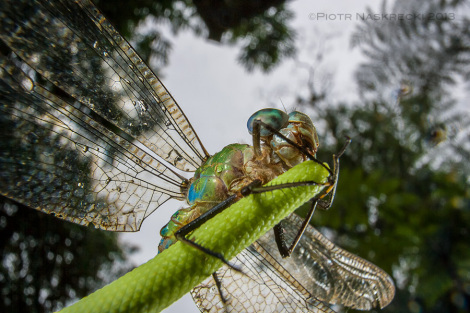
Costa Rican dragonfly (Gynacantha tibiata) drying off its wings after the rain. Taken with a Canon 16-35mm lens with an added extension tube Canon EF 12 II; lighting was provided by a twin flash Canon MT-24EX.
A few days ago I posted the first part of an introduction to wide-angle macrophotography, and here is the conclusion.
Illumination. In order for the illusion that you are a lilliput looking at the giant world to work, the background of a wide-angle macro shot should be well and evenly lit, and the frontmost, focal element of the photo should not be in the shade. One of the most difficult problems to overcome in wide-angle macrophotography is proper illumination of the subject right in front of the lens, which may be just millimeters away. This includes trying to avoid casting a shadow on it. There is not one, simple solution to this problem, and the type of lighting to use will depend on the distance from the lens, time of day, angle of the sun, brightness of the background, reflectance of the subject etc.
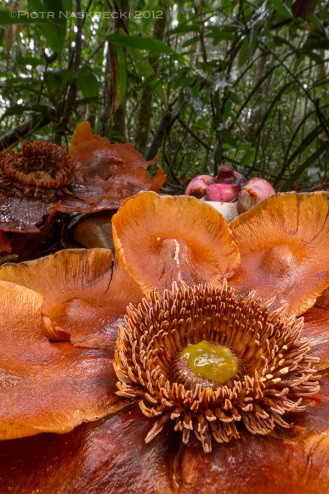
In order to get a sharp photo of this Clusia grandiflora flower on the dark, shady forest floor in Suriname I filled a small Ziplock bag with soil and leaves, and used it as a beanbag. This 1 second exposure was taken with a Canon EF 14mm on Canon 7D, illuminated with twin flashes Canon MT-24EX.
What works for me in many cases is a single, remote flash in a softbox (Canon 580EXII in a Photoflex LiteDome XS, either wireless or attached with a Camera Shoe Cord). Because of the proximity of the subject to the lens, a flash mounted directly on top of the camera will not work, as it will cause the shadow of the lens to fall right in front of it. If the subject is not moving (e.g., a flower, an insect sitting motionlessly), and the sun is not directly behind my back, I use a collapsible golden or silver reflector to bounce ambient light at the subject. I also use custom made brackets to mount a pair of small, twin flashes (Canon MT-24EX) about 20 cm away from the front of the lens, which are then diffused with wide pieces of thin, white plastic (made of a cheap plastic folder bought at Staples.) I have also had good experience using inexpensive, flexible brackets DMM-901 (I am not sure who makes these, but they can be ordered here.)
Stabilization. The illumination and sharpness of the background is what often makes or breaks a wide-angle macro photograph. Since it would be difficult to rely entirely on flashes to evenly light the background in a shot that encompasses a part of the landscape, most wide-angle macro photos will require long, often 0.1-2 sec exposures. For this reason a large proportion of my wide-angle photography is made from a tripod. I use a Gitzo GT2531EX, which is light, very sturdy, and allows me to position the camera in any way I want – from close to the ground to 177 cm high. But even a higher number of my photos are taken with the camera resting either on a “beanbag” (in most cases simply a Ziplock bag filled with sand or soil) or directly on the ground. Sometimes, when I am trying to get a really low angle for a subject on the ground, I quickly dig a little hole, place a plastic bag at the bottom (to keep the camera dry), and position the camera in it. In this way the lens is exactly at the level of the ground, or even slightly below it.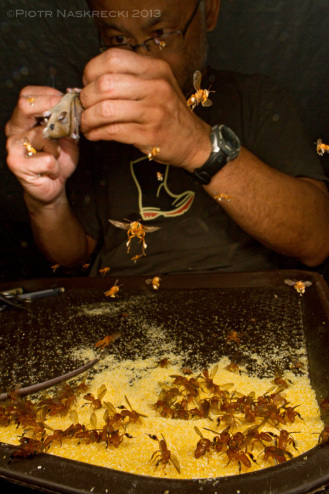
Wide-angle macrophotography usually requires long exposures, and thus capturing fast-moving animals is difficult. Here, mammalogist Burton Lim is processing bats collected in Suriname, while small stingless bees are gorging on cornmeal that he uses to dry his specimens. I was able to freeze the action and partially expose the background using twin flashes Canon MT-24EX, and Canon EF 14mm mounted on Canon 7D.
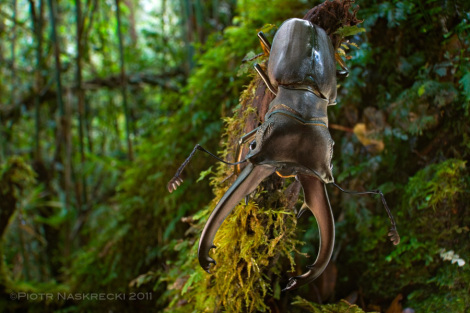
A stag beetle (Cyclommatus eximius) from the highlands of New Britain, Papua New Guinea. Here I used a Canon 16-35mm with an extension tube, mounted on a full-frame camera Canon 1Ds MkII.
For wide-angle photography high in the trees or in situations where a regular tripod or a beanbag cannot be used, I rely on a Gorillapod flexible tripod, which can be wrapped around a branch, providing pretty secure stabilization.
One critically important piece of equipment in wide-angle macro is a remote shutter release, which reduces the chances of vibration caused by pressing the shutter. Recently I have started using a Vello ShutterBoss Timer Remote, which is both less expensive and more functional than the original Canon one.
Camera selection. To say that within the last 10 years the quality of digital cameras has grown exponentially is of course a truism. My cell phone’s camera has twice the resolution and much better low light performance than my first, $5,000 digital SLR (Nikon D1x). You can now walk into a Walmart, and for $399 get an SLR capable of taking photos that were virtually impossible 20 years ago. The latest “pro-sumer” bodies are capable of taking shots in near darkness, and the high ISO performance of almost all SLRs is bound to make you wonder why anybody still uses ISO lower than 400. My point is that cameras have become so sophisticated that no matter which one you chose, the images taken with it can be outstanding. Nonetheless, in wide-angle macrophotography the choice of the right SLR body matters. (I should mention that many point-and-shoot cameras can be a great choice for wide-angle macrophotography, but my experience with them is limited.)
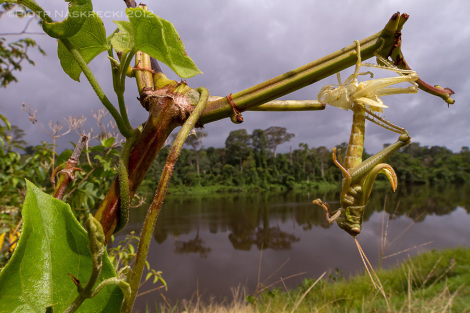
Even in extreme wide-angle closeups, flash illumination is not always required. This molting grasshopper in Suriname was photographed using only ambient light with a hand-held Canon 7D camera and Canon 14mm lens.
It may seem counterintuitive that, although you will be using wide-angle lenses, the best cameras for wide-angle macro are not those with a full-frame sensor (35mm equivalent), but rather those with a smaller one. Such cameras give the illusion of producing an image that is magnified, usually by a factor of 1.3-1.6, compared to a full-frame sensor, but in fact the image is simply cropped. Why then buy a wide-angle lens if 30-60% of its coverage is going to be cropped by the small sensor? This is because the shorter (wider) the lens the more likely it is to introduce distortion and chromatic aberration at the edges of the frame, and these faults become more pronounced at close focal ranges, and even more so when the lens is mounted on an extension tube. By using a camera with a sensor smaller than full-frame, you are tapping into the “sweet spot” of the lens – the image captured by the sensor uses mostly the central, sharpest and least distorted portion of the lens, while still retaining the wide-angle perspective (albeit with a smaller coverage.) And of course a camera with a smaller (higher crop) sensor will help you magnify the small, central subject of the photo.
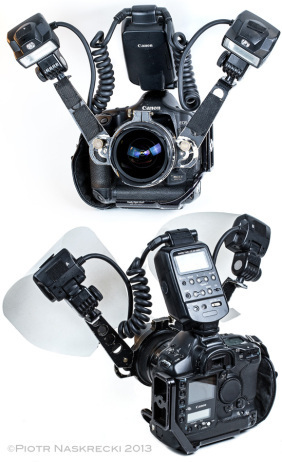
Custom flash brackets that I use in most of my wide-angle macrophotography. They are designed to be mounted directly on the front of the lens, and fit lenses with the diameter of 58-82mm.
My favorite camera for wide-angle macro is Canon 7D, which has the cropping factor of 1.6; occasionally I also use Canon 1D MkII, with the cropping factor of 1.3. The only time when I use a full-frame body is when I shoot with a Canon 16-35mm with an extension tube – this is because animals larger than 40 mm or so fill up the frame, and block the background if a camera with the sensor smaller than full-frame is used.
I hope that this brief overview of my approach to wide-angle macrophotography was helpful, and will encourage you to try and perfect your own methods. As with any other photographic techniques, practice makes masters, and no amount of theoretical information will ever replace simply going into the field and chasing critters with your lens. And if you have any specific questions, comments, or suggestions, leave them in the comments below or drop me a line.
A cluster of mushrooms (possibly Hygrocybe sp.) in a New England forest. [Canon 1D MkII, Sigma 15mm, ambient light]
Filed under: Equipment, Photo technique, Wide angle


January 3, 2013
Getting low and wide – Part 1
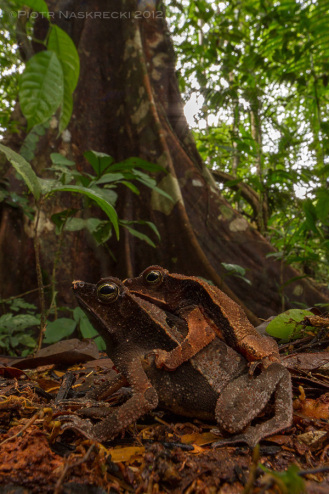
Getting low to the ground enhances the illusion that you are as small as the subjects of the photo. I photographed these leaf toads (Rhinella lescueri) in Suriname using a Canon EF 14mm on Canon 7D with an angle viewfinder, and lighted it with a single speedlight Canon 580EXII in a softbox.
Shortly after I had become a proud owner of my first real SLR camera (the wonderful Nikon n6006 – an unexpected Christmas gift from my wife), I decided that what I wanted to do with this magical piece of equipment was to document life that was two or three orders of magnitude smaller than traditional subjects of nature photography. But I wasn’t satisfied with simple macro portraits of katydids and frogs –I was desperate to capture their environment as well, and show a clump of lichens the way a fly sees it – a towering forest, three dimensional, and complex. This, of course, turned out to be easier said than done.
Ever since I saw David Attenborough’s “Trials of Life”, and the mind-boggling sequence of weaver ants tending caterpillars (to this day this remains one of the best macro sequences ever filmed – if you haven’t seen it, buy it right now), I have been obsessed with trying to photograph insects and other small organisms in a way that removes the element of scale. I want to show them as part of the landscape, and see the world from their perspective. It took me a while to figure out that the way to do it is to forget about macro lenses, but instead use lenses designed for much, much larger subjects: wide angle lenses traditionally used for landscape photography. These are lenses of the focal length shorter than 50mm. After many years of trying to get a hang of wide-angle macrophotography I am still hoping to improve my results, but at least I have been able to isolate and try to work on those elements that are needed for a good a wide-angle macro shot. Here are a few tips based on my experience so far.
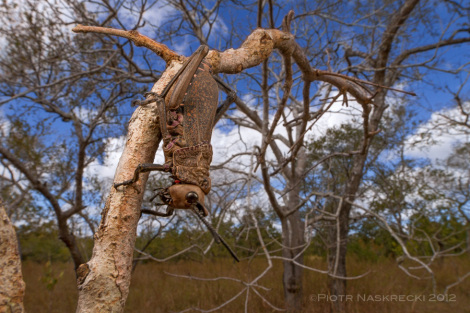
The greater the depth of field the stronger the illusion that you are part of the scene. This photo of a foam grasshopper (Dictyophorus griseus) from Mozambique was taken with a Canon EF 14mm on Canon 7D, illuminated with twin flashes Canon MT-24EX.
Perspective. What truly makes a good wide-angle shot is the impression that you, the viewer, are standing right inside the frame, and that you are looking at the world from the perspective of a mouse. Macro photography that uses lenses of the focal length longer than 50mm enlarges the subject, but a macro photograph taken with a lens shorter than 50mm shrinks the viewer. The shorter the lens the more striking the effect of “shrinkage”, and it is amplified by a low angle of the photo. For example, we never see mushrooms from below, looking up at their underside, and such a perspective enhances the impression of suddenly being transported to the world of towering, giant mushrooms. My two favorite lenses that provide just the right perspective are Canon EF 16-35mm f/2.8L (often mounted on an extension tube – see below) and Canon EF 14mm f/2.8L. Occasionally I also use a Sigma 15mm f/2.8 EX DG Diagonal Fisheye, although this lens creates a very strong barrel distortion of the field of view. A very helpful piece of equipment that allows me to get a ground level point of view is the right angle viewfinder (Canon Angle Finder C).
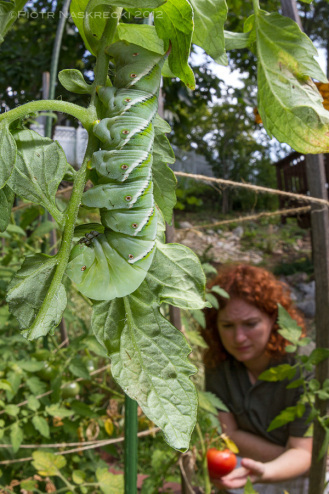
A tomato hornworm (Manduca quinquemaculata) on tomatoes in our garden. This photo was taken using a Sigma 15mm lens – notice a strong barrel distortion, particularly visible in the curvature of the stick on the right.
Focus. A wide-angle photograph must have a focal point that is perfectly sharp. Unfortunately, most wide-angle lenses are not designed to focus close enough to fill the frame with subjects as small as insects. Luckily, an inexpensive extension tube can turn almost any wide-angle lens into a wide-angle macro lens. I use a Canon Extension Tube EF 12 II, which allows me to focus on and fill the frame with subjects as small as a grasshopper. The shortest lenses that can be used with it should have the focal length of 16mm or longer – if a lens is shorter than 16mm the point of focus will be inside the lens. Thus, neither Canon EF 14mm nor Sigma 15mm can be used with an extension tube, but luckily both focus close enough so that I have been able to use them to photograph subjects as small as ants (they don’t fill the frame with an individual ant, but that’s not the point of wide-angle macrophotography anyway.)
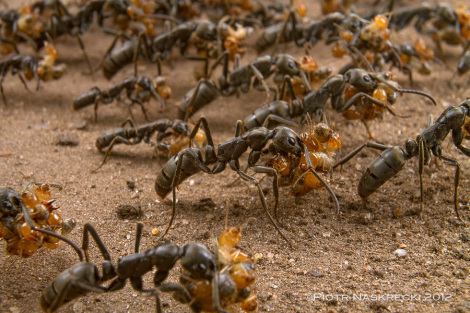
A column of Matabele ants (Pachycondala analis) returning from a successful raid on a colony of termites in Gorongosa National Park in Mozambique. This photo was taken with a Canon 16-35mm lens with an added extension tube Canon EF 12 II; lighting was provided by a diffused twin flash Canon MT-24EX.
Depth of field. The sharper the objects in the background, the stronger the illusion that the frontmost, focal subject of the photo is huge (relative to the you, the viewer). In order to achieve a maximum depth of field, use the shortest lens you can and stop the aperture as far down as possible. I usually use the aperture of f/16 or f/22, which means that the exposure time tends to be quite long, often 0.5-2 sec, even in the middle of the day.
————
Stay tuned for the second part of the post where I will discuss how to stabilize the camera, illuminate the scene, and select the best equipment for wide-angle macrophotography. In the meantime I highly recommend a recent e-book “Wide-Angle Macro: The Essential Guide” by Paul Harcourt Davies and Clay Bolt, which is filled with great practical information and superb examples.
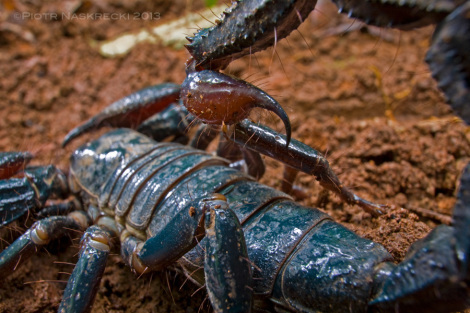
Wide-angle macro does not necessarily mean that the scene must include a part of the landscape. It can also be used to draw attention to a detail of the main subject, such as the stinger of this scorpion (Pandinus imperator) from Ghana. Here I used a Canon 16-35mm lens with an added extension tube Canon EF 12 II on a Canon 1Ds MkII body; despite the closeness to the subject (its telson was nearly touching the lens) I was able to use a simple reflector to illuminate the scene.
Filed under: Equipment, Macrophotography, Photo technique, Wide angle


December 31, 2012
The most interesting find of 2012
Caterpillar of Paraclystis integer, a termite inquiline from Mozambique (lateral and dorsal views) [Canon 7D, Canon 100mm macro, 3 speedlights Canon 580EXII]
Well, the first year of my blogging is nearly over, but I think I still have time for one more story. And it is a good one.Earlier this year I was in the spectacular Gorongosa National Park in Mozambique, doing my usual things – chasing katydids with a net and a recorder, taking pictures, and flipping rocks. And under one of these rocks I found something that truly tested the extent of my entomological knowledge. One evening, while looking for ants and crickets on the rim of a deep limestone gorge, I lifted a big, flat boulder and underneath found a colony of termites. But something wasn’t right. Why were some of these termites longer? And wierd looking? It took me a few seconds to realize that the colony was filled with creatures that looked very much like termites, and behaved in a similar fashion, but clearly were something else.
A fragment of the carton structure of the Schedorhinotermes lamanianus colony with termite soldiers and caterpillars of Paraclystis integer [Canon 7D, Canon 100mm macro, 3 speedlights Canon 580EXII]
At first I couldn’t even guess what these creatures were. Mutant termites, an undescribed phylum, aliens? There were hundreds of them, easily as many as the real termites. I scooped a bunch into a container to have a closer look. OK, they were not aliens – they had mandibles and six short legs. So they were insects. But what kind? I had no idea.Later I examined them under a microscope and saw that they had crocheted prolegs on the abdomen – so they must be caterpillars, that is moth or butterfly larvae. But they also had strange processes all along the body that looked strangely similar to candy-corn. The peculiar caterpillars turned out to be Paraclystis integer, members of the cloth-moth family (Tineidae). But what were they doing in the termite colony?
Although these caterpillars and their presence in the colonies of the termites of the genus Schedorhinotermes have been known since early 1900′s nobody really knows what the nature of the relationship between these two groups of insects is. It is tempting to speculate that the caterpillars’ strange candy-corn processes produce something that the termites like, but this is not the cases. They appear to be purely of a sensory nature and are not connected to any glands. Even more strangely, the caterpillars seem to have little tolerance for termites, and often chase them away if approached. At times, however, they allow termites to lick something from the dorsal part of their abdomen. There is one casual observation made in the late 1960′s (Harris 1968. Proc. R. ent. Soc. Lond B. 37: 103-113) suggesting that the larvae accompany the termites on their foraging trips at night, but what exactly they feed on is unknown.
I am hoping that in 2013 the mystery of the candy-corn caterpillars and termites will be one I am able to solve. And if I do, you will be first to learn about it on The Smaller Majority blog. Thanks for reading and a Happy New Year!
Filed under: Behavior, Lepidoptera


Piotr Naskrecki's Blog
- Piotr Naskrecki's profile
- 9 followers


![Ice crawler Grylloblatta campodeiformis from Alberta, Canada. [Canon 10D. Canon 100mm, ambient light]](https://i.gr-assets.com/images/S/compressed.photo.goodreads.com/hostedimages/1389030578i/7973952.jpg)
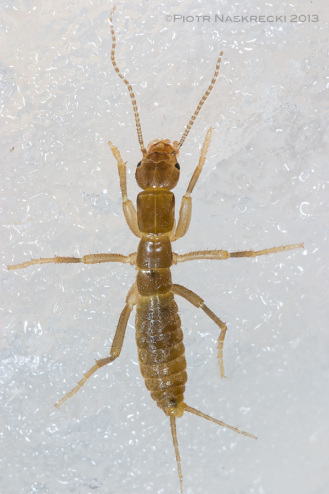
![In contrast to North American species, the fossorial Asian species, like this Japanese Galloisiana nipponensis, which spend their entire life deep underground, are blind and never forage on the surface. [Canon 1Ds MkII, Canon MP-E 65mm, 2 speedlights Canon 580EX]](https://i.gr-assets.com/images/S/compressed.photo.goodreads.com/hostedimages/1389030578i/7973954.jpg)
![Cool, shady, and humid subalpine and alpine valleys in the beautiful Chichibu-Tama-Kai National Park not far from Tokyo are an example of the typical habitats of Japanese ice crawlers. [Canon 1Ds MkII, Canon 16-35mm]](https://i.gr-assets.com/images/S/compressed.photo.goodreads.com/hostedimages/1389030578i/7973955.jpg)
![Japanese species of ice crawlers, or garoamushi, are distinctly larger than their American counterparts and, because of their higher metabolic rates, faster and more difficult to catch. The species most common in Japan is Galloisiana nipponensis. Garoamushi are found primarily in areas that have a mean annual temperature of 12°C, but even in these cool areas they hide deep in the soil throughout most of the year. [Canon 1Ds MkII, Canon MP-E 65mm, 2 speedlights Canon 580EX]](https://i.gr-assets.com/images/S/compressed.photo.goodreads.com/hostedimages/1389030578i/7973956.jpg)
![The very first solifugid that I ever saw. When I posted this photo on Flickr, the always hilarious Brandi Schuster commented, “Solifugid. That sounds like the noise that I would make if I ever saw one of those fuckers in real life.” [Canon G10]](https://i.gr-assets.com/images/S/compressed.photo.goodreads.com/hostedimages/1389030578i/7973959.jpg)
![Spider-free living. Hey, if I believed it, that was all that mattered. [Canon G10]](https://i.gr-assets.com/images/S/compressed.photo.goodreads.com/hostedimages/1389030578i/7973960.jpg)
![The Verandah. Doesn’t it look delightful? Note the interesting choice to install a screen on a door that doesn’t meet the floor, and the lack of a screen on the window. [Canon G10]](https://i.gr-assets.com/images/S/compressed.photo.goodreads.com/hostedimages/1389030578i/7973961.jpg)
![A storm passes over the top of a mountain in Cederberg at the end of a scorchingly hot day. This place is worth every degree and every arachnid above my comfort level. [Canon 7D, Canon 14mm]](https://i.gr-assets.com/images/S/compressed.photo.goodreads.com/hostedimages/1389030578i/7973962._SY540_.jpg)
![Glorious Cederberg. [Canon 7D, Canon 14mm]](https://i.gr-assets.com/images/S/compressed.photo.goodreads.com/hostedimages/1389030578i/7973963.jpg)
![In Eastern Cape of South Africa, a beautiful flock of butterflies is puddling on the side of a road. [Canon 7D, Canon 16-35mm]](https://i.gr-assets.com/images/S/compressed.photo.goodreads.com/hostedimages/1389030578i/7973975.jpg)
![A cluster of puddling butterflies on a sandy river bank in Guyana [Canon 5D, Canon 100-400mm]](https://i.gr-assets.com/images/S/compressed.photo.goodreads.com/hostedimages/1389030578i/7973976.jpg)
![African veined white (Belenois gidica) extracting minerals from wet sand (Eastern Cape, S. Africa) [Canon 7D, Canon 100mm macro]](https://i.gr-assets.com/images/S/compressed.photo.goodreads.com/hostedimages/1389030578i/7973977.jpg)
![Puddling butterflies turned out to be remarkably skittish – in order to get a wide angle shot of these insects I had to leave the camera in the sand, and use a radio controlled trigger (seen on the left) to get the shots. [Canon 5D, Canon 100-400mm]](https://i.gr-assets.com/images/S/compressed.photo.goodreads.com/hostedimages/1389030578i/7973978.jpg)
![This large aggregation of butterflies puddling in Guyana is probably made up mostly of male individuals. [Canon 1Ds MkII, Canon 16-35mm]](https://i.gr-assets.com/images/S/compressed.photo.goodreads.com/hostedimages/1389030578i/7973979.jpg)
![A female snow scorpionfly (Boreus brumalis) is completely wingless and carries a long ovipositor. [Canon 1D MkII, Canon MP-E 65mm, 2 speedlights Canon 580EX]](https://i.gr-assets.com/images/S/compressed.photo.goodreads.com/hostedimages/1389030578i/7973984._SX540_.jpg)
![The male has highly modified wings that resemble a pair of scissors. He uses them to claps the female's elongated mouthparts during mating. [Canon 1D MkII, Canon MP-E 65mm, 2 speedlights Canon 580EX]](https://i.gr-assets.com/images/S/compressed.photo.goodreads.com/hostedimages/1389030578i/7973985.jpg)
![If he cannot get hold of her mouthparts, the male will sometimes grab the female's antennae to secure her position on his back. [Canon 1D MkII, Canon MP-E 65mm, 2 speedlights Canon 580EX]](https://i.gr-assets.com/images/S/compressed.photo.goodreads.com/hostedimages/1389030578i/7973986._SX540_.jpg)
![Stalk-eyed fly (Diasemopsis fasciata) from Gorongosa National Park in Mozambique [Canon 7D, Canon MP-E 65mm, 3 speedlights Canon 580EXII]](https://i.gr-assets.com/images/S/compressed.photo.goodreads.com/hostedimages/1389030578i/7973989.jpg)
![With eyes on such long stalks, keeping them clean is not an easy task. Not surprisingly, these flies spend a lot of time on personal hygiene. [Canon 7D, Canon MP-E 65mm, 3 speedlights Canon 580EXII]](https://i.gr-assets.com/images/S/compressed.photo.goodreads.com/hostedimages/1389030578i/7973990._SY540_.jpg)
![Males of the blue land crab (Cardisoma guanhumi) from the Dominican Republic sport giant claws used in territorial display and combat. [Nikon D1x, Nikkor 17-35mm]](https://i.gr-assets.com/images/S/compressed.photo.goodreads.com/hostedimages/1389030578i/7973994.jpg)
![A cluster of mushrooms (possibly Hygrocybe sp.) in a New England forest. [Canon 1D MkII, Sigma 15mm, ambient light]](https://i.gr-assets.com/images/S/compressed.photo.goodreads.com/hostedimages/1389030579i/7974004.jpg)
![Caterpillar of Paraclystis integer, a termite inquiline from Mozambique (lateral and dorsal views) [Canon 7D, Canon 100mm macro, 3 speedlights Canon 580EXII]](https://i.gr-assets.com/images/S/compressed.photo.goodreads.com/hostedimages/1389030674i/7974030.jpg)
![A fragment of the carton structure of the Schedorhinotermes lamanianus colony with termite soldiers and caterpillars of Paraclystis integer [Canon 7D, Canon 100mm macro, 3 speedlights Canon 580EXII]](https://i.gr-assets.com/images/S/compressed.photo.goodreads.com/hostedimages/1389030674i/7974031.jpg)

